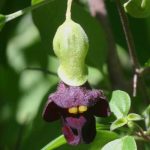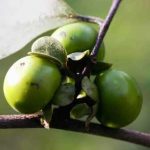TREE LIFE
APRIL 1991
MASHONALAND CALENDAR
Tuesday 2nd April: Botanic Garden walk with Tom Muller. Park your car at the Herbarium where we will meet Tom at 1645 hours for 1700 hours.
Sunday 21st April: John and Lillian Cottrill have kindly invited us to spend the day on Guitingwood in the scenic Mutepatepa District. John has developed and preserved an interesting piece of woodland which we will explore in the morning. After lunch we can look at some riverine vegetation nearby. The ‘Butterfly Man’ alias Rob Pare may be there and we hope he will tell us something about butterflies and their dependence of various plant species. As it is a fair distance from Harare it would be nice to make it a really worthwhile so let’s meet at the homestead at 0900 hours. We look forward to meeting up with some Bindura, Matepatepa and Shamva folk.
Saturday 27th April: Walk with Mark on the Falcon Golf Course Hatfield which was found to be very interesting on the last visit. Everybody is welcome to join Mark on the walk.
Tuesday 7th May: Botanic Garden Walk
MATABELELAND CALENDAR
Sunday, 7th April: To Pasipas (Anne Visser’s Kloof Farm) to do revision on the many Acacias in the area, then on to the Kalahari sand area to see the flowering Baikiaea plurijuga (teak) and the fruiting Ricinodendron rautanenii (wild almond / balsawood) and across the road to a completely different type of area. Meet at Falls Road Motors at 8.30 am – and about 12 km from there – morning only – bring tea and chairs.
Wednesday 17th April: Ian McCausland’s Hillside Evening walk – Aloe Garden, Lower Hillside Dam at 5.00 pm — Remember Mchew.
Sunday 5th May 1991: To Richard and Bookie Peek’s exciting property “Stone Hills” – 5 km From Marula. There is Erythrophysa transvaalensis in the area – we have to find it! Meet at Grafotype, 81 Plumtree Road at 0800 hours.
Wednesday, 15th May 1991: McHew – make it a monthly date at 5.00 pm.
The eagerly awaited trip to Ray Stephens‘ “Shumba Shava Mkulu” in the eastern Matopos was a huge success. It was hot, energetic and wearying, but the reward was 126 species, including two new to the area . . . Eight trees have now been found of Cussonia spicata var. trigtera (forest cabbage tree) (identified by Steven Mavi via Maureen) which certainly has an interesting leaf structure, and the other was a lone 35ft Adansonia digitata (baobab), 2 000 ft above sea level near the edge of a 600ft precipice, which, as was suggested, must have been planted by the Rozwi peoples about 200 years ago. Nearby were the remains of their stone walling, adding to the interesting overall environment of trees, rock formations and wide distant views.
Since our last visit the area has been extended to include “Grey Tore” and “Besna Kabila” which allowed an elongated walk to different area. Acacias were thin on the floor, only A. seiberiana being seen, but the Ficus species were well represented by F. glumosa, F. ingens, F. natalensis, F. sur, F. thonningii and F. verruculosa (fruiting). All the Maytenus on our card were there, M. heterophylla subsp. puberula, M. senegalensis and M. undata; while the Obetia tenax (nettle) was discovered by an unfortunate member.
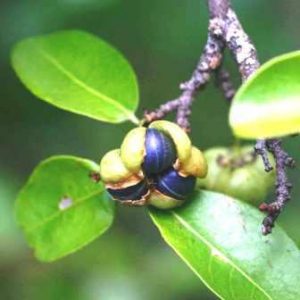
Margaritaria discoidea Photo: Bart Wursten. Source: Flora of Zimbabwe
Unusuals such as Erythrina lysistemon (for Matabeleland), Olinia vanguerioides, Olax dissitiflora, Margaritaria discoidea, Halleria lucida (wild fuchsia tree), Ptaeroxylon obliquum (sneezewood – with its strange leaf shape, Sericanthe andongensis, Teclea rogersii and rounded off by the very exciting (for us) Chionanthus battiscombei with its beautiful leaves.
Of the borderline “tree/shrub” species we had a Field day with Aloe excelsa (many tall ones), Elephantorrhiza goetzei (large clumps), Euphorbia cooperi (standing proud among the rock formations E. griseola (scrambling , E. ingens (candelabra) E. matabelensis (the tree full of flowers and fruit), and E. tirucalli (rubber hedge); groves of Barleria albostellata with their showy white flowers; all three of the Lippia species L. javanica (herb), L. oatesii (lemon) and L. wildii (spearmint); Osyris lanceolata and Rhocissus tridentata; Sesbania sesban and Pterolobium stellatum (redwing) and with great excitement the Cyathea dregei.
A rare one for us the beautifully leaved Antidesma venosum was found, one specimen weighed down by “witches fingers” Sarcostemma viminale while the Strychnos were well represented by S. cocculoides (corky bark), S. madagascariensis (small fruit), S. matopensis (even smaller) and the large fruited S. spinosa (monkey orange). Looking down on the Brachystegia glaucescens (the mis-named mountain acacia) was a glorious and for us, an unusual sight, on our way down to the Sigonya stream fringe which included the Ochna holstii, O. puberula and O. schweinfurthiana.
There were 17 trees not seen from the previous visit – making a total of 143 species found in this small botanical paradise. Thank you Roy, for trying to save for posterity, this absolute gem of Matopos.
-KEN BLAKE
McHEW
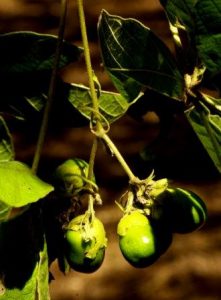
Vitex payos. Photo: Bart Wursten. Source: Flora of Zimbabwe
Our first evening meeting was a great success. Teacher Ian Mccausland certainly did his homework, and we were enthralled by his theme, “Autumn – the fruiting time”. First we had Vitex payos, the fruit was still green, but were told that payos was named after a river. Second was Carissa edulis which is member of the APOCYNACEAE family and wondered if that fruit was named edible, as most others of that family are poisonous.
The Sclerocarya birrea was next and had the sweetest marulas I have ever tasted. Azanza garckeana followed, and as a member of the MALVACEAE (mallow) family is related to hibiscus, cotton and ochra and has a mucous taste! Kei apple, Dovyalis zeyheri was the last of the 5 fruiting trees, and the sharp thorns were pointed-out!
We were then presented with photocopies (white-man’s magic) of 5 different grasses and told to look for them. The answers were even more difficult than tree names,
i.e. Rhynchelytrum repens (Natal red); Eragrostis racemosa (Miami love grass); Hyperthelia dissoluta yellow thatching grass; Sporobolus pyramidalis -(cat’s tail) and our most unfavourite, Heteropogon contortus (assegai grass).
The two bonuses of the evening were to walk around in the cool, and to hear another voice other than Ken Blake’s! A fascinating outing, thank you Ian, see you next month.
-KEN BLAKE
BOTANIC GARDEN WALK
On our Botanic Garden walk this month we looked at those few monocotyledons that grow into trees. We would like to thank one of our varsity students, Francisca Mutapi for writing it up.
The flowering plants are divided into two, the dicotyledons and monocotyledons.
Two of their many distinguishing features are the venation on the leaves and the arrangement of their vascular bundles. Dicots have net venation and monocots have parallel venation. Monocots do not have the ability to make wood whereas dicots do. Wood is a result of secondary thickening of the vascular tissues that are responsible for transporting water. In dicots, the vascular tissues develop in vascular bundles that form a ring around the outer side of the stem. The phloem tissue, which transports food from the leaves to the roots occurs on the outside of this ring just under the bark. So when a dicotyledon is ring-barked the phloem is removed and the roots are-starved to death. Monocots however have vascular bundles scattered throughout the stem; they do not form a ring. Ring-barking monocots will not kill the plant and these trees cannot be aged from annual rings as the existence of annual rings depends on the vascular bundles being in a ring.
Although monocots do not have the ability to make wood, they have become more flexible and have specialized as herbaceous plants.
PALMS
Corner (1966) did extensive work on Palms and put forward a lot of ideas, many of which are no longer accepted! According to him, the palm marked the beginning of everything, from these he derives the orchids and the dicots. He came to this conclusion as the oldest fossil leaves were from palms. (Palms often grow in wet areas where fossilization occurred easily). He also suggested that he had never been able to find an indigenous coconut palm as they were always associated with human beings. Since the embryo of the palm does not stop growing (i.e. does not undergo dormancy) if the seed fell into the sea (as is usually suggested) it would germinate, drown and then die. The story of a coconut palm seed landing on a beach and growing is thus not confirmed.
Because palms never add new vascular tissue to their trunks, palms do not usually branch. In addition palms like Borassus may take 15 — 20 years for the plant to establish its set number of vessels before forming a trunk. Once it has its set number of vessels, the plant can then grow in height. And since they have a set number of vessels, the plant will have a set number of leaves forming its crown and for every new leaf that grows one old leaf must die. The life of a palm leaf differs for every palm species; it is interesting to note that in the case of some palms, just like most biological clocks that follow natural phenomenon; loss of leaves may follow the lunar cycle — with a leaf being lost every 27 — 29 days (e.g. the Actiniorhytis from Singapore).
Some palms have developed very small leaves whereas one exception the Doum palm, Hyphaene thebaica does show dichotomous branching as occurs in ferns.
During the walk we examined the following specimens:
Borassus aethiopica: This palm has fan shaped leaves with the leaflets arranged like a gutter. This palm’s leaf is the largest fan leaf. The trunk has swellings around the center which stores food but local people sometimes believe spirits reside in these swellings.
Phoenix reclinata is the wild date palm. It occurs in the Dyke area and at the Victoria Falls. It has feather shaped leaves and unlike all the other feather leafed palms like Elaeis, its leaflets form gutters and not roofs.
The Bindura bamboo forms clumps, as one stem grows, it stores food for the next stem which will grow longer and fatter than the previous one. The clump grows larger and then flowers in one year and dies.
Raphia farinifera has the longest leaves in the world, these can grow to 20m long. It has compound leaves and occurs in the north of this country near Centenary, and in the Burma Valley.
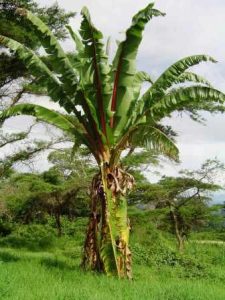
Ensete ventricosum. Photo: Bart Wursten. Source: Flora of Zimbabwe
The wild banana, Ensete ventricosum has no side shoots, it uses the leaf stalk for support. The stalk attaches to the stem. When its leaf stage is over, the banana plant will flower, and bear fruit with a lot of seeds and very little flesh — after this the plant dies. The ilala palm, Hyphaene petersiana, often sits on the ground for a very long time, branching to form new plants and then one grows in height. The spines on their petioles can be used to make fish hooks.
PALM GROWTH: when the seeds of some palms e.g. Hyphaene are planted, a stalk (the placenta) grows out of the seed, carrying with it the embryo. The embryo consists of a plumule (which will form the leaves) and a radical (which will form the root). This stalk will plant the embryo some distance from the actual seed. The palms and other monocotyledons undergo basipetel growth i.e. growth of structures from the base of the plant towards the apex – and when the leaf dies, it dies from the tip going down: this is why lawn can be cut without being killed, because cutting removes only the older and dying regions. Palms can flower as they go along year after year (as in date palms) or they can store up their energy for a massive reproductive phase just before they die.
-Francisco Mutapi
MARCH 18th – AUDLEY END, TREVOR & MAY GORDON’S FARM IN DARWENDALE
It was a unique experience on Sunday to see cattle, game and tobacco side by side within the same enclosure. The figures Trevor gave us for his section were : 50 hectares of dry land tobacco, 50 hectares of irrigated tobacco, 500 head of cattle and approximately 200 head of game. We saw sable, wildebeest, zebra and impala and ‘evidence‘ of the giraffe – feeding troughs perched up in trees and a well browsed cussonia. In the morning we walked through a woodland/kopje area where the vegetation has been virtually untouched for 40 years. We found two of the three Commiphoras. C. africana and C. mollis but not C. mossambicensis. There were huge specimens of Afzelia quanzensis, Diplorhynchus condylocarpon and abbreviata and behind the house, some Catunaregam spinosa ‘trees’ which were gigantic.
Some interesting points : Strychnos innocua is distinguished from S. madagascariensis by having a bark which ‘rubs’ easily.
The extra Floral nectaries of Parinari are two minute black dots or glands hidden in the russet fur of the petiole.
The branching pattern in Terminalias, – out and up to the next rosette, is called the Aubreville model.
Senna singueana (Cassia singueana) is often festooned with cones of caterpillar droppings or grass.
Kim has given us the Fig pollination wasp story before and I imagined wasps the size of household wasps. But of course the pollinating wasps must be small enough to get in through the apical pore. The parisitizing wasps which we found on the green Figs of a Ficus sur were tiny too, about 2mm in length. Behind each wasp uses a black hair 1 cm long which I kept trying to brush away until I realized that that was the ovipositor. Apparently they have a remarkable method of injecting the ovipositor into a Fig with the end of the ovipositor firmly anchored in the Fig surface, the wasp walks backwards, detaching thorax from the abdomen- by an extensible connection, until thorax meets ovipositor tip and abdomen is overhead the now vertical ovipositor. Then by contracting the connecting piece the abdomen is brought back down to the thorax and the ovipositor is forced through the flesh of the Fig. None of the wasps performed for us – they were too harassed by numerous ants continuously running over the figs. A sucking bug (Hilda who 7 .7 ) is responsible for the sticky secretions which bring the ants. They are detrimental to the egg laying of the parasitizing wasps and hence by safe guarding the eggs the pollinating wasps they contribute to the success of the Fig tree.
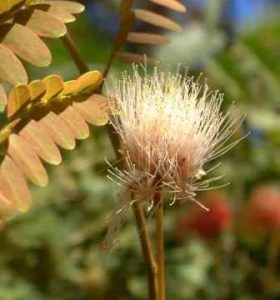
Albizia zimmermannii flowers. Photo: Rob Burrett. Source: Flora of Zimbabwe
In the afternoon we explored the kopje behind the house where Trevor has planted trees, grown either from seed or truncheon, from all round the country. I was particularly delighted to find all four Dovyalis species within meters of each other, making for easy comparison. There were some fine Albizia zimmermannii, – the Zambezi valley albizia, which I had not seen before. Sterculia murex from S. Africa (in Van, Wyk’s book on the Kruger National Park) was growing well and Baphia massaiensis was in Flower. Gardenia posoquerioides was pointed out, growing in the garden — much excitement as I have not seen this in the Botanical Gardens and have looked for it in‘ vain in the Eastern Districts.
A fabulous day, thank you the Gordons.
-Kim Damstra
MUKUVISI WOODLAND NOTES
First a Correction : Last month we published Peggy Izzett’s notes on the big Frost of 1968 – we made
a very material error :- At 6.30 am on 13.6.1968 the thermometer recorded 23 degrees Fahrenheit. NOT 34°F as published. Now anywhere outside the polar regions 23°F is a pretty low temperature. I shiver at the thought
Also last month, I mentioned a dead individual Burkea africana – I have looked at it since writing — it is still standing quite firmly – that is to say 12 years after its execution, and situated where this dead wood is, at the south end of‘ the motor racing circuit, it has been protected from hot burn for the whole period it has been standing dead. Had it been exposed to real fire it would have burnt away long ago.
These thoughts have therefore caused me to revise some theories” about the demolition of the Syzygium cordatum along the Makubusi River. When I first got to know the woodland in 1973, this species had been almost completely extirpated all along the river strip. At that time I laid the blame completely on human pressure. In light of Peggy’s anecdote, I now think it likely that the ‘big Frost was responsible for much of the damage to frost tender water berry growth.
However, human kind does not completely escape blame, as before the frost much of the mixed species composition along the river had probably been cleared thus exposing the water berry to frost damage.
Luckily, Syzygium cordatum survived severe frost damage within the canopy vegetation in the gulley along the lower Chiraura and thus seed was spread out from this refuge. Why therefore, did I not see signs of frost damage when I first went along this length of‘ the Makubusi only five years after the big frost, well – both hot burn and the human fuel wood collector would have soon moved the evidence. What I still do not know precisely about S. cordatum is the best environment for seed to set, and so facilitate re-generation. Partly, this is my own fault as sometimes after a lapse of years, when I have returned to a study an area I have been unable to draw distinction between 100% self‘ sown seedlings, and plants grown from seed I have scattered with intention of giving nature a hand to get moving.
All this underlines the responsibility of us humans to avoid habitat destruction initially. Easy said, so often we do it without realisation. A case in point happened in Inyanga National Park a couple of decades ago. One day, I searched several miles up and down stream, along the banks of the Inyangombe River, seeking among the predominantly exotic vegetation for Syzygium seedlings, finally I found one youngster. A sturdy young plant about 40 cm high. Thereafter, on every visit to Inyanga I would go and see my ward, I visualised it reaching maturity and spreading its offspring along the river and so fathering a forest. Alas, it reached about 1.5 meters, it was close to the old narrow main road bridge, then tragedy struck. A nasty petrol bowser accident happened, the petrol polluted the river for miles down stream and the fish were killed.
Conservationists bewailed this degradation of the environment. I was the only one who observed that part of the wrecked vehicle descended on my adopted baby water berry and it died instantly.
That was the end of‘ that chapter of attempted Forest regeneration.
-V c.H.
NYARUPINDA CATCHMENT March— 1991
During the past few weeks the catchment has felt like Commiphora country, low altitude hot dry bush and woodland. At the moment more water is being used for irrigation than is flowing into the dams, so it is uncertain whether there will be enough for the cropping programme. High temperatures, strong winds and light rainfall has been the weather pattern.
The search for new plants has revealed several specimens which have been identified at the Herbarium, here they are in alphabetical order.
On a stony hillside near home a herb with tall stems topped with a flat inflorescence of pale pink everlasting flowers was Helichrysum oxypetalum. A bush clump on an old termitarium yielded a species of shrubby Hibiscus, soon to be identified by Mr Drummond. (Ed. please note).
A quaint specimen was “Green Snake“ Sarcostemma viminale also called milk rope, melktou; its smooth slender cylindrical leafless green stems poked up through other vegetation on a rocky outcrop. Opposite/branching was discernible, both flower and fruit were absent, these are worthy of close observation when they occur intermittently when conditions are favourable. These plants are unaffected by the water shortage because they are ‘succulents’ and belong to the family ASCLEDIADACEAE.
Last year at this time, the fruits which look like green Bougainvillea flowers were located next door on Malewano farm. Its yellow flowers with five fringed petals were gathered from the ground last week. These and a twig thought to belong to it were identified in Harare; surprise surprise! This Triaspis flowered at the top of an Albizia tree, near by on Chepstow Farm. This species does not appear on the Tree Atlassing check list, it is probably classified as a liane, not a shrub.
Perhaps Peanut Butter Cassia/Senna (C/S didymobotrya) should be added to the list of non-indigenous plants which have become naturalised in Zimbabwe. This species is ornamental but offensive, the smell becomes over—powering and care must be taken to avoid contaminating tender skin, mouth or eyes with any part of this plant because it is peppery and burns. Isolated bushes occur on Chepstow, its bright yellow erect racemes are conspicuous during the rainy season.
A hollow Mufuti in the garden houses a swarm of bees, they have made honey from the Miombo woodland. The bees told us when the plot of Paspalum notatum was in flower, they started gathering before dawn. There is something about this beautiful dark green grass that cattle do not like, the horses eat it when there is nothing as green in their paddock.
-Benedicta Graves
CHAIRMAN, KIM DAMSTRA


